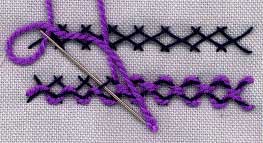Twisted lattice band

![]()
![]() Twisted lattice band creates an attractive band which can be used as a border or where you might place a braid.
Twisted lattice band creates an attractive band which can be used as a border or where you might place a braid.
With the fabric stretched in an embroidery hoop or frame, a row of double herringbone stitch (version 1) is worked quite loosely. Space the stitch wider than normal. The lacing on the second row will tighten the stitches.

Make sure that the double herringbone stitches are worked correctly with part of the second row of herringbone stitch threaded under the first row of herringbone. If you make an error here, the lacing will not work. Lace the herring bone foundation stitches as shown in the illustration. Thread the needle under the herringbone in an upward direction then move across the crossed bars of the herringbone turn the needle and thread in an upward direction again. The lacing is worked in two journeys. Work along the base of the herringbone foundation stitches then along the top. Use a tapestry needle to avoid splitting the foundation herringbone stitch. With this stitch, take care to lace and not to pick up any of the fabric.
Twisted lattice band can be worked in two threads of differing colour or weight. Rows can he arranged as a filling. Beads or French knots can be placed in the grid like pattern that forms. This is particularly effective when a metallic thread is used for the lacing.
Herringbone Stitch Family
There are many other stitches in this group. The stitches that I have listed here in the Herringbone family are:
And related to herringbone is the chevron stitch group
